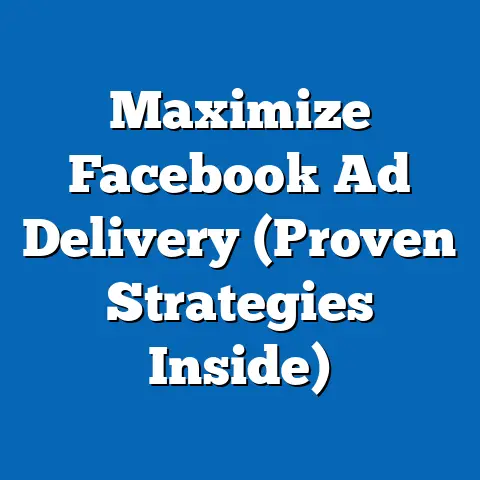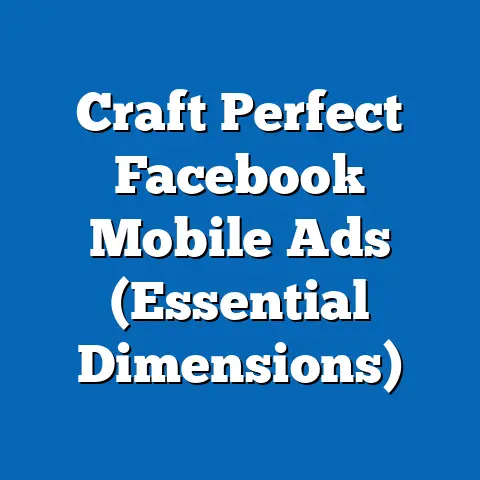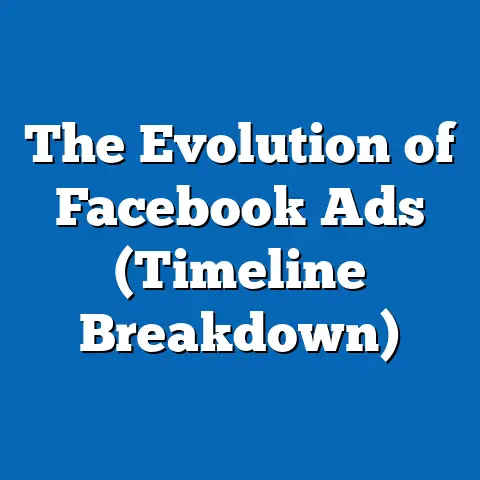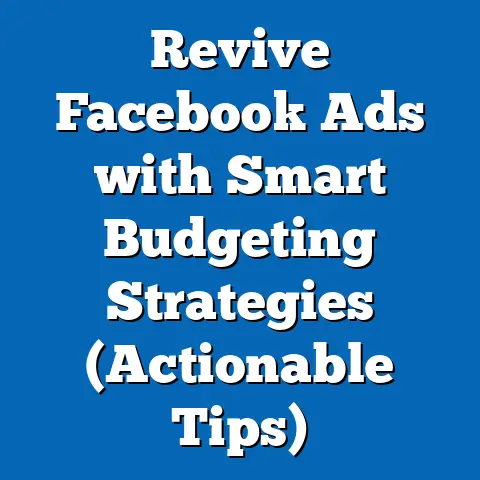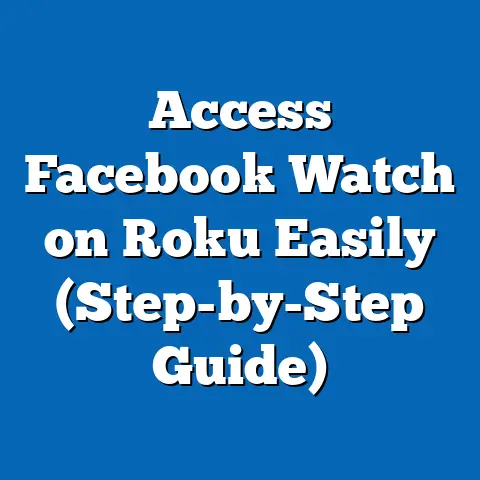Boost Engagement with Effective Facebook Video Ads (Pro Tips)
“Video ads are only effective for large brands with big budgets.” I can’t tell you how many times I’ve heard this sentiment echoed in marketing circles. It’s a common misconception, and frankly, it’s one that holds back countless businesses from unlocking the true potential of Facebook advertising. The truth is, with the right strategy, businesses of all sizes can leverage video ads to drive significant engagement, build brand awareness, and ultimately, boost their bottom line.
Facebook, with its billions of active users, remains a powerhouse for video content. In fact, according to recent statistics, videos generate significantly more engagement than other types of content on the platform. Think about it: when you’re scrolling through your feed, what catches your eye? Is it a block of text, or a captivating video? I bet it’s the latter!
In this article, I’m going to debunk that myth and equip you with actionable pro tips to create compelling Facebook video ads that resonate with your target audience, regardless of your budget. We’ll dive into the fundamentals of Facebook video ads, explore how to optimize your videos for maximum impact, and uncover strategies to drive meaningful engagement. Get ready to transform your video ad game!
Understanding Facebook Video Ads
Facebook video ads are, simply put, paid advertisements that feature video content. They come in various formats, each designed to capture attention and deliver your message in a compelling way. You’ve probably seen them:
- In-stream ads: These play within other videos, similar to TV commercials.
- Stories ads: These appear between users’ Stories, offering a more immersive and vertical viewing experience.
- Feed ads: These show up directly in the user’s newsfeed, blending seamlessly with organic content.
- Carousel ads: These allow you to showcase multiple videos or images in a single ad, perfect for highlighting different products or features.
What makes Facebook video ads so powerful? Well, Facebook’s algorithm loves video content. It prioritizes videos in users’ feeds, meaning your video ad has a higher chance of being seen compared to a text-based or image-based ad. Plus, Facebook offers incredibly granular targeting options, allowing you to reach specific demographics, interests, behaviors, and even custom audiences based on your existing customer data.
In today’s crowded digital landscape, video has become the king of content. Studies show that consumers are more likely to remember and engage with brands that use video marketing. According to a recent report by HubSpot, 54% of consumers want to see more video content from a brand or business they support. If you’re not incorporating video into your Facebook advertising strategy, you’re missing out on a massive opportunity to connect with your audience and drive results.
Takeaway: Facebook video ads offer a powerful way to reach your target audience, leveraging the platform’s algorithm and granular targeting options. Understanding the different formats and the importance of video in today’s digital landscape is the first step to creating effective campaigns.
Pro Tip #1: Hook Your Audience in the First Few Seconds
In the fast-paced world of social media, attention spans are shorter than ever. You have mere seconds to grab your audience’s attention and convince them to keep watching. If your video ad doesn’t immediately hook them, they’ll simply scroll on by. It’s harsh, but it’s the reality.
So, how do you create a compelling opening that stops the scroll? Here are a few strategies I’ve found particularly effective:
- Use Strong Visuals: Start with eye-catching visuals that are relevant to your brand and message. Think vibrant colors, dynamic animations, or intriguing scenes.
- Ask an Intriguing Question: Pose a question that directly addresses your target audience’s pain points or desires. This creates curiosity and encourages them to seek the answer within your video.
- Tell an Emotional Story: Humans are wired for stories. Start with a brief, relatable anecdote that evokes emotion and connects with your audience on a personal level.
- Highlight a Key Benefit: Immediately showcase the value proposition of your product or service. What problem does it solve? What benefits does it offer?
Let me give you a real-world example. I worked with a local bakery that was struggling to gain traction on Facebook. Their initial video ads were bland and generic, simply showcasing their baked goods. We revamped their strategy and created a video ad that started with a close-up shot of a freshly baked croissant, followed by the question, “Craving the perfect breakfast treat?” Within seconds, we saw a significant increase in view rates and engagement.
Takeaway: Capturing attention quickly is crucial for video ad success. Experiment with strong visuals, intriguing questions, emotional storytelling, and highlighting key benefits in the first few seconds of your video.
Pro Tip #2: Optimize for Mobile Viewing
Let’s face it: most people are consuming content on their smartphones. In fact, according to Statista, mobile devices account for a significant percentage of Facebook’s advertising revenue. That means your video ads need to be optimized for the mobile viewing experience.
Here are some tips for designing mobile-friendly video ads:
- Use Vertical or Square Aspect Ratios: Vertical (9:16) and square (1:1) videos take up more screen real estate on mobile devices, maximizing their visibility.
- Increase Text Size: Make sure any text in your video is large enough to be easily readable on smaller screens.
- Prioritize Visual Clarity: Use high-quality visuals that are clear and easy to understand, even on smaller screens.
- Add Subtitles or Captions: Many users watch videos with the sound off, especially in public places. Subtitles or captions ensure that your message is still conveyed, even without audio.
I once consulted with a clothing retailer that was running video ads with a horizontal aspect ratio. While the videos looked great on desktop, they appeared small and insignificant on mobile devices. We switched to a vertical aspect ratio and added captions, and the results were astounding. We saw a dramatic increase in view rates, engagement, and click-through rates.
Takeaway: Mobile optimization is essential for reaching your target audience. Use vertical or square aspect ratios, increase text size, prioritize visual clarity, and add subtitles or captions to ensure your video ads are engaging on mobile devices.
Pro Tip #3: Focus on Quality Content Over Length
In the world of video ads, shorter is often better. While there’s no magic number for ideal video length, I’ve generally found that concise, high-quality content tends to perform better than lengthy, rambling videos. It’s a common misconception that longer videos are inherently more engaging. In reality, viewers are more likely to tune out if your video drags on without delivering value.
What’s the sweet spot? It depends on the format and your target audience. For in-stream ads, shorter videos (15-30 seconds) are often most effective. For feed ads, slightly longer videos (30-60 seconds) may work well. And for stories ads, stick to the 15-second limit.
The key is to focus on delivering a clear, concise message that resonates with your audience. Cut out any unnecessary fluff and get straight to the point. Here are a few tips for creating high-quality, concise video ads:
- Define Your Key Message: What’s the one thing you want viewers to take away from your video?
- Write a Script: A well-written script ensures that your video stays on track and delivers your message efficiently.
- Edit Ruthlessly: Cut out any scenes or dialogue that don’t contribute to your key message.
- Use Compelling Visuals: High-quality visuals can help to capture attention and keep viewers engaged.
Takeaway: Quality trumps quantity when it comes to video ad length. Focus on delivering a clear, concise message that resonates with your audience. Experiment with different video lengths to see what works best for your brand and target audience.
Pro Tip #4: Include a Clear Call-to-Action
A call-to-action (CTA) is an instruction that tells your audience what you want them to do after watching your video. It’s a crucial element of any effective video ad, as it guides viewers towards the desired outcome, whether it’s visiting your website, making a purchase, signing up for a newsletter, or simply learning more about your brand.
Without a clear CTA, your video ad is essentially a missed opportunity. You’ve captured your audience’s attention, but you haven’t given them a clear path to take the next step.
Here are some examples of effective CTAs for video ads:
- “Visit our website to learn more.”
- “Shop now and get 20% off your first order.”
- “Sign up for our newsletter and get exclusive deals.”
- “Download our free ebook today.”
- “Contact us for a free consultation.”
The placement and timing of your CTA are also important. I recommend including your CTA towards the end of your video, when viewers are most engaged and receptive to your message. You can also include a visual CTA, such as a button or text overlay, to make it even more prominent.
Takeaway: A clear call-to-action is essential for driving results with your video ads. Include a CTA towards the end of your video, and make it visually prominent with a button or text overlay.
Pro Tip #5: Test and Analyze Your Video Ads
Creating effective Facebook video ads is an ongoing process of testing, analyzing, and iterating. What works for one brand may not work for another, so it’s important to continuously experiment with different elements of your video ads to see what resonates best with your target audience.
A/B testing, also known as split testing, is a powerful technique for comparing two versions of a video ad to see which one performs better. You can test different thumbnails, CTAs, video lengths, targeting options, and more.
Here are some key performance metrics to track when analyzing your video ads:
- View Rate: The percentage of people who watched your video.
- Engagement Rate: The percentage of people who interacted with your video (e.g., likes, comments, shares).
- Click-Through Rate (CTR): The percentage of people who clicked on your CTA.
- Conversion Rate: The percentage of people who completed the desired action (e.g., made a purchase, signed up for a newsletter).
By analyzing these metrics, you can identify what’s working and what’s not, and make adjustments to your video ads accordingly.
Takeaway: Testing and analyzing your video ads is crucial for continuous improvement. Use A/B testing to compare different versions of your ads, and track key performance metrics to identify what’s working and what’s not.
Conclusion
Effective Facebook video ads can be a game-changer for your business, regardless of your size or budget. By debunking common misconceptions and implementing these pro tips, you can create compelling video ads that capture attention, drive engagement, and ultimately, boost your bottom line.
Remember, the key is to focus on creating high-quality content that resonates with your target audience. Experiment with different formats, lengths, and CTAs to see what works best for your brand. And most importantly, continuously test, analyze, and iterate to improve your video ad strategy over time.
Now, it’s time to put these pro tips into action! Go create your next video ad campaign and track the results. I’m confident that you’ll see a significant boost in engagement and achieve your marketing goals. Good luck!

